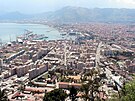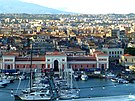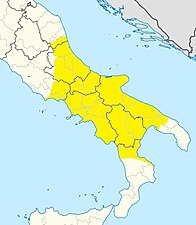Southern Italy
Southern Italy
| |
|---|---|
 | |
| Country | Italy |
| Regions | |
| Area | |
| • Total | 123,024 km2 (47,500 sq mi) |
| Population | |
| – Regional languages | |
Southern Italy (Italian: Sud Italia, Italian: [ˈsud iˈtaːlja], or Italia meridionale, Italian: [iˈtaːlja meridjoˈnaːle]; Neapolitan: 'o Sudde; Sicilian: Italia dû Suddi), also known as Meridione (Italian: [meriˈdjoːne]) or Mezzogiorno (Italian: [ˌmɛddzoˈdʒorno]; Neapolitan: Miezojuorno; Sicilian: Menzujornu; lit. 'Midday'), is a macroregion of Italy consisting of its southern regions.
The term "Mezzogiorno" today mostly refers to the regions that are associated with the people, lands or culture of the
The island of
Etymology of Mezzogiorno
In a similar fashion to
The term came into vogue after the annexation of the
Regions
Southern Italy is generally thought to comprise the administrative regions that correspond to the geopolitical extent of the historical Kingdom of the Two Sicilies, including Abruzzo, Apulia, Basilicata, Calabria, Campania, Molise, and Sicily. The island of Sardinia, although being culturally, linguistically and historically less related to the aforementioned regions than any of them is to each other, is frequently included as part of the Mezzogiorno,[10][13] often for statistical and economical purposes.[14][13][15]
Geography

Southern Italy forms the lower part of the Italian "boot", containing the ankle (Campania), the toe (Calabria), the arch (Basilicata), and the heel (Apulia), Molise (north of Apulia) and Abruzzo (north of Molise) along with Sicily, removed from Calabria by the narrow Strait of Messina. Separating the "heel" and toe of the "boot" is the Gulf of Taranto, named after the city of Taranto, which is at an angle between the heel and the boot itself. It is an arm of the Ionian Sea. The island of Sardinia, situated to the west of the Italian peninsula and right below the French island of Corsica, may also often be included.
On the eastern coast is the
The climate is mainly

The region is geologically very active, except for Salento in Apulia, and highly seismic: the 1980 Irpinia earthquake killed 2,914 people, injured more than 10,000 and left 300,000 homeless.
History
Prehistory and antiquity
In the 8th and 7th centuries BCE, for various reasons, including demographic crisis (famine, overcrowding, etc.), the search for new commercial outlets and ports, and expulsion from their homeland, Greeks began to settle in southern Italy.[16] Also during this period, Greek colonies were established in places as widely separated as the eastern coast of the Black Sea, Eastern Libya and Massalia (Marseille).
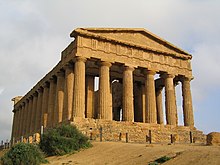
They included settlements in Sicily and the southern part of the Italian Peninsula. The first Greek settlers found Italy inhabited by three major populations:
). The relationships between the Greek settlers and the native peoples were initially hostile (especially with the Iapygian tribes). The Hellenic influence eventually shaped their culture and way of life.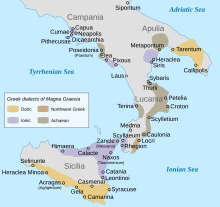
The Romans used to call the area of Sicily and coastal southern Italy Magna Graecia ("Great Greece") since it was so densely populated by coastal Greek colonies; the ancient geographers differed on whether the term included Sicily or merely Apulia and Calabria—Strabo being the most prominent advocate of the wider definitions.
With this colonisation,
Many of the new Hellenic cities became very rich and powerful, like Neapolis (Νεάπολις,
Although many of the Greek inhabitants of Magna Graecia were entirely

After
Middle Ages
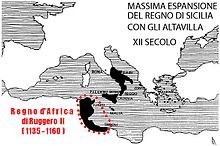
Following the

From 999 to 1139, the
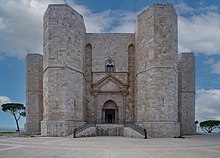
In Sicily,
In 1266, conflict between the
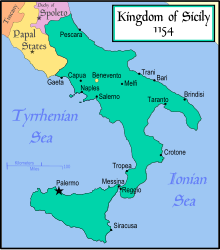
Early modern history
In 1442,
The kingdom remained disputed between France and Spain for the next several decades. The French efforts to gain control of it became feebler as the decades went on, and Spanish control was never genuinely endangered. The French finally abandoned their claims to the kingdom by the

The administration of the Kingdom of Naples and Sicily, as well as the Duchy of Milan, was run by the Council of Italy. The island of Sardinia, which had fully come to be under Iberian sovereignty in 1409 upon the fall of the last indigenous state, was an integral part of the Council of Aragon instead and remained as such until the first years of the XVIII° century, when Sardinia was ceded to Austria and eventually handed over to the Alpine-based House of Savoy in 1720.
After the
Early 19th century
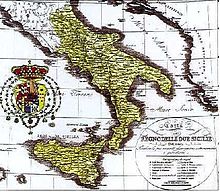
Being a member of the
After Napoleon's defeat, King Ferdinand IV was restored by the
Southern and Northern Italy in 1860
At the time of Italian unification, the gap between the former northern states of Italy and the southern two Sicilies was significant: northern Italy had about 75,500 kilometers of roads and 2,316 kilometers of railroads, combined with a wide range of canals connected to rivers for freight transportation; iron and steel production was 17,000 tons per year. By contrast, in the former Bourbon southern state, there were 14,700 kilometers of roads, 184 kilometers of railroads (only around Naples), no canals connected to rivers and iron and steel production was 1,500 tons per year.

In 1860, illiteracy rates on the Italian peninsula averaged 75%, with the lowest level of 54% in the northwestern Kingdom of Sardinia (also known as "Piedmont"), and the highest in the south, where illiteracy in the Kingdom of the Two Sicilies reached 87%.[28]
In 1860 the southern merchant navy amounted to 260,000 tons, whereas the northern merchant navy came to 347,000 tons, apart from the Venetian navy annexed in 1866 and assessed at 46,000 tons. In 1860 the whole Italian merchant navy was the fourth largest in Europe at about 607,000 tons.[29] The southern merchant navy was made up of sailing vessels mainly for fishing and coastal shipping in the Mediterranean Sea and it had very few steamships, even if one of the first steamers was built and fitted out in Naples in 1818. Both merchant and military navy were insufficient compared to the great coastal extent of southern Italy defined by the Italian historian Raffaele De Cesare: "… a great pier towards the south".[30]
In the article "This is Not Italy! Ruling and Representing the South", it is clear how the northern elites considered the south. The Piedmontese north felt the need to invade the Kingdom of the Two Sicilies and establish a new form of governance based on the northern system, since they viewed the south as under-developed and lacking in social capital. These views of the south can largely be attributed to the letters of correspondents in southern Italy who sent biased letters to leaders of the north, specifically
In an attempt to explain the striking difference between the annexed territory of the former Two Sicilies and the economic and political powerhouse centred in the north, racist theories were postulated, suggesting that such a divide had its roots in the coexistence of two mostly incompatible races.[32]
Denis Mack Smith, British historian, describes the radical difference between northern and the newly annexed southern Italy in 1860, for these two halves were on quite different levels of civilization, pointing out that the Bourbon in the Kingdom of the Two Sicilies were staunch supporters of a feudal system and that they had feared the traffic of ideas and had tried to keep their subjects insulated from the agricultural and industrial revolutions of northern Europe.[33]
The study by Mack Smith is confirmed by the Italian historian and left-wing politician
The living conditions of the people of the Kingdom of the Two Sicilies are also illustrated by Raffaele De Cesare,[35] who reports that the king of Naples Ferdinand II had no interest in doing useful works to improve the neglected condition of public hygiene, particularly in the provinces where scarcity of sewer systems and often water shortages were known issues.[36]
The problem of brigandage is explained in the book Heroes and Brigands by the southern Italian historian and politician Francesco Saverio Nitti, outlining that brigandage was endemic in southern Italy, since the Bourbons themselves relied on it as their military agent.[37] Unlike southern Italy, there was little brigandage in the other annexed states of northern and central Italy, like the Kingdom of Lombardy–Venetia, the Duchy of Parma, the Duchy of Modena, the Grand Duchy of Tuscany and the Papal States.
According to the southern Italian historian Giustino Fortunato,[38] and Italian institutional sources[39] the problems of southern Italy existed way before Italian unification, and Giustino Fortunato emphasizes that the Bourbons were not the only ones responsible for the problems of the South, which had ancient and deep origins also in previous centuries of poverty and isolation, caused by foreign domination and foreign governments.
In literature, the period of 1860 was depicted by Sicilian writer Giuseppe Tomasi di Lampedusa in his famous novel Il Gattopardo (The Leopard), set in Sicily at the time of Italian unification. In a famous final scene, Prince Salina, when invited to join the senate of unified Italy, tells a high-ranking Piedmontese officer "…the Sicilian will never want to change, because the Sicilian feels perfect…". With these and other words the author underscores the problem Sicilians had, having to change their old lifestyle while remaining on their island. The novel was adapted by Luchino Visconti for his homonymous 1963 film The Leopard.
After 1861
The southern economy greatly suffered after the Italian unification and the process of industrialisation was interrupted. Poverty and
Demography
Population
| Rank | City | Region | Population | ||
|---|---|---|---|---|---|
| 1 | Naples | Campania | 955,503 | ||
| 2 | Palermo | Sicily | 659,894 | ||
| 3 | Bari | Apulia | 319,482 | ||
| 4 | Catania | Sicily | 311,777 | ||
| 5 | Messina | Sicily | 231,708 | ||
| 6 | Taranto | Apulia | 195,279 | ||
| 7 | Reggio Calabria | Calabria | 179,049 | ||
| 8 | Cagliari | Sardinia | 154,108 | ||
| 9 | Foggia | Apulia | 150,185 | ||
| 10 | Salerno | Campania | 132,640 | ||
| Sources: 2019 Demo Istat[42] | |||||
Economy

Starting from the unification of Italy in 1861–1870, a growing economic divide between the Northern provinces and the Southern half of Italy became evident.
After the rise of
Starting from the 1950s, the Cassa per il Mezzogiorno was set up as a huge public master plan to help industrialise the south, that aimed to do this in two ways: by land reforms creating 120,000 new small farms, and through the "Growth Pole Strategy" whereby 60% of all government investment would go to the south, thus boosting the southern economy by attracting new capital, stimulating local firms, and providing employment. However, the objectives were largely missed, and as a result the south became increasingly subsidised and state-dependent, incapable of generating private growth itself.[48] Presently, huge regional disparities still persist. Problems still include pervasive organised crime and very high unemployment rates.
Due to southern Italy's lack of progress in bettering the area, it has had record numbers of emigration. The most prevalent issue in southern Italy is its inability to attract businesses, and therefore create jobs. Between 2007 and 2014, 943,000 Italians were unemployed. From this figure, 70% were Italians from the south.[49] Employment in the south is ranked the lowest when compared to countries in the European Union.[49] Italians from the south are also ranked the lowest in terms of financial contributions into the economy of Italy from immigrants.[50] In southern Italy tourism, distribution, food industries, wood furniture, whole sale, vehicle sales, sales in mineral and artisan fields are among the leading areas contributing to the projected employment growth.[51] The economy of the south heavily relies on tourism. It attracts tourists through its rich historical background.
A report published in July 2015 by the Italian organization SVIMEZ shows that southern Italy has had a negative GDP growth in the last seven years, and that from the year 2000 it has been growing half as much as Greece.[52] In 2016, southern Italy's GDP and economy was growing twice as much as northern Italy's.[53] According to Eurostat figures published in 2019, southern Italy is the European area with the lowest employment percentages: in Apulia, Sicily, Campania and Calabria, less than 50% of the people aged between 20 and 64 had a job in 2018. This is largely due to the low participation of women in the workforce, as slightly more than 30% of the women are employed, compared to a national and European average of 53.1% and 67.4%, respectively.[54][55]
In southern Italy, which contains eight cohesion areas (Sicily, Calabria, Campania, Molise, Puglia, Abruzzo and Basilicata), a public–private partnership known as SMEI Italy serves as a catalyst for private investment and supports economic growth and employment creation.[56][57] Over €1 billion in finance has been catalyzed in these eight locations to far, supporting almost 5 000 SMEs and small mid-caps.[58]
Per capita GDP by region
Today, Abruzzo is the richest of the regions of southern Italy, while Calabria appears as the poorest.[59][60]
| Rank | Region | 2017 | % of nationwide average |
|---|---|---|---|
| 12 | 25,000 | 86.51 | |
| 14 | 21,400 | 74.05 | |
| 15 | 20,900 | 72.32 | |
| 16 | 20,100 | 69.55 | |
| 17 | 18,700 | 64.71 | |
| 18 | 18,500 | 64.01 | |
| 19 | 17,700 | 61.25 | |
| 20 | 17,400 | 60.21 | |
| — | 28,900 | 100.00 |
Culture
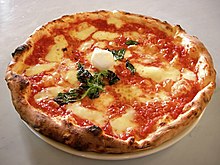
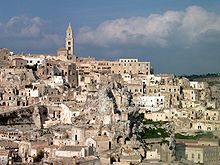
The regions of southern Italy were exposed to some different historical influences than the rest of the peninsula, starting most notably with Greek colonisation in Magna Graecia. Greek influence in the south was dominant until Latinisation was completed by the time of the Roman Principate. Greek influences returned by the late Roman Empire, especially following the reconquests of Justinian and the Byzantine Empire.
Sicily, a distinctive Norman–Arab–Byzantine culture throughout the Middle Ages, was captured by Muslims and turned into an Emirate for a period, and elements of Arab culture were introduced via Sicily to Italy and Europe. The rest of the mainland was subject to a struggle of power among the Byzantines, Lombards, and Franks. In addition, the Venetians established outposts as trade with Byzantium and the Near East increased.
Until the Norman conquests of the 11th and 12th centuries much of the south followed Eastern rite (Greek) Christianity. The Normans who settled in Sicily and southern Italy in the Middle Ages significantly impacted the architecture, religion and high culture of the region. Later, southern Italy was subjected to rule by the new European nation states, first the Crown of Aragon, then Spain, and then Austria. The Spanish had a major impact on the culture of the south, having ruled it for over three centuries.
Jewish communities lived in Sicily and southern Italy for over 15 centuries, but in 1492 King Ferdinand II of Aragon proclaimed the Edict of Expulsion. At their height, Jewish Sicilians probably constituted around one tenth of the island's population. After the Edict, they partially converted to Christianity and some moved to the Ottoman Empire and other places in Italy and Europe. In the 19th century, street musicians from Basilicata began to roam worldwide to seek a fortune, most of them would become professional instrumentalists in symphonic orchestras, especially in the United States.[63]
Southern Italy has many major tourist attractions, such as the Palace of Caserta, the Amalfi Coast, Pompeii, Sassi di Matera, Trulli di Alberobello and other archaeological sites (many of which are protected by UNESCO). There are also many ancient Greek cities in southern Italy, such as Sybaris and Paestum, which were founded several centuries before the start of the Roman Republic. Some of its beaches, woodlands and mountains are preserved in several National Parks; a major example is the Pollino, between Basilicata and Calabria, that hosts the largest national park in Italy.[64]
In recent years, southern Italy has experienced a revival of its traditions and music, such as the Neapolitan song and the tarantella.
- Linguistic borders of the Italo-Dalmatian southern Italian
-
Range of the southern Italian dialects (Neapolitan)
-
Range of the extreme southern Italian dialects
See also
- National Institute of Statistics (Italy)
- NUTS statistical regions of Italy
- Italian NUTS level 1 regions:
- Northern Italy
- Central Italy
- Meridionalism
- Southern Italy autonomist movements
References
- ^ "Statistiche demografiche ISTAT". www.demo.istat.it. Archived from the original on 17 December 2020. Retrieved 4 October 2019.
- ^ "Legge 482". Webcitation.org. Archived from the original on 24 September 2015. Retrieved 17 October 2015.
- ^ «Con questa denominazione si indica lo Stato costituito nel dic. 1816 con l’unificazione dei regni di Napoli e di Sicilia, che restaurava l’autorità borbonica su tutta l’Italia meridionale; fu mantenuta fino all’ott. 1860, quando, tramite plebiscito, fu votata l’annessione al regno di Sardegna.» "Regno delle Due Sicilie in Dizionario di Storia". www.treccani.it.
- ^ «Mezzogiorno, region in Italy roughly coextensive with the former Kingdom of Naples.» "Mezzogiorno". Encyclopædia Britannica. Retrieved 23 July 2016.
- ^ «Meridionale: in part.: che fa parte delle regioni continentali e insulari del Mezzogiorno d'Italia (delimitate convenzionalmente dai fiumi Garigliano e Sangro), le quali, in età prerisorgimentale, costituivano il Regno delle due Sicilie.» Battaglia, Salvatore (1961). Grande dizionario della lingua italiana, UTET, Torino, V. X, p.160.
- ^ «Il regno meridionale, Napoli e Sicilia con 6 milioni e 200 mila abitanti,... pare in principio per certa foga di riforme e per valori d'ingegni filosofici e riformisti gareggiare con la Lombardia austriaca.» Carducci, III-18-21, citato in Grande dizionario della lingua italiana, UTET, Torino, V. X, p.160.
- ^ Luigi Mendola. "Kingdom and House of the Two Sicilies".
- ^ «Tra le maggiori novità del secolo ci fu proprio il ritorno all'indipendenza del regno meridionale, che riunì in un unico stato indipendente e sovrano il Mezzogiorno insulare e continentale.» Francesca Canale Cama; Daniele Casanova; Rosa Maria Delli Quadri (2017). Storia del Mediterraneo moderno e contemporaneo. Napoli: Guida Editori. p. 173.
{{cite book}}: CS1 maint: multiple names: authors list (link) - ^ "Il rapporto annuale Svimez sull'economia del Mezzogiorno". 2007.
- ^ a b "Classificazione economica ISTAT" (PDF) (in Italian). Archived from the original (PDF) on 9 January 2015. Retrieved 23 October 2009.
- ^ "Classificazione demografica ISTAT" (in Italian). Archived from the original on 15 April 2016. Retrieved 23 October 2009.
- ^ "Mezzogiorno". Encyclopædia Britannica. Retrieved 23 July 2016.
- ^ ISBN 9781317798385.
- ISBN 9783825881771.
- ISBN 9781426207105. Retrieved 23 July 2016.
- ISBN 0-89236-751-2.
- ISBN 978-0-521-68495-8.
- ^ "Multilinguismo in Sicilia ea Napoli nel primo Medioevo" (PDF) (in Italian). Retrieved 15 July 2023.
- ^ "Per la difesa e la valorizzazione della Lingua e Cultura Greco-Calabra" (PDF) (in Italian). Retrieved 15 July 2023.
- ^ "Una lingua, un'identità: alla scoperta del griko salentino" (in Italian). 25 May 2020. Retrieved 15 July 2023.
- ^ "Sicilian Peoples: The Normans - Best of Sicily Magazine - Normans in Sicilian History". www.bestofsicily.com.
- ISBN 0-374-95297-3.
- ISBN 978-0-7864-3462-6.
- ISBN 0-521-43774-1.
- ^ Colletta, Pietro (1858). History of the Kingdom of Naples (1858). University of Michigan.
Edict of Bayonne.
- ^ "The Battle of Tolentino, Joachim Murat". Tolentino815.it. 7 October 2007. Archived from the original on 1 February 2008.
- ^ Blanch, L. Luigi de' Medici come uomo di stato e amministratore. Archivio Storico per le Province Napoletane. Archived from the original on 24 October 2008. Retrieved 21 April 2011.
- ^ "The Italian Unification (L'Unificazione Italiana)- Treccani with contribution of Aspen Italy – Section IV – pages 417–418 illiteracy, p. 419 iron/steel, p. 420 roads and channels, p. 421 railroads )" (PDF).
- ISBN 9788868124229
- ^ De Cesare, Raffaele (6 July 1900). "La fine di un regno (Napoli e Sicilia)". Città di Castello, S. Lapi – via Internet Archive.
- ^ "This Is Not Italy!" Ruling and Representing the South, 1860–1861
- Fratelli Bocca.
- ISBN 0472108956, p. 3.
- ^ "Antonio Gramsci La Questione Meridionale". archive.org.
- ^ Raffaele De Cesare (1845–1918), southern Italian historian and politician
- ^ De Cesare, Raffaele (6 July 1900). "La fine di un regno (Napoli e Sicilia)". Città di Castello, S. Lapi – via Internet Archive.
- ISBN 9788881674695– page 33
- ^ Fortunato, Giustino (6 July 1911). "Il Mezzogiorno e lo stato italiano; discorsi politici (1880-1910)". Bari G. Laterza – via Internet Archive.
- ^ "La Scuola per i 150 anni dell'Unità d'Italia - Il problema del Mezzogiorno - Il divario di partenza". www.150anni.it.
- ^ Roland Sarti, Italy: A Reference Guide from the Renaissance to the Present (2004) pp 567–8
- FiveThirtyEight.com. Archived from the originalon 5 December 2013. Retrieved 16 December 2009.
- ^ "Statistiche demografiche ISTAT". demo.istat.it. Archived from the original on 24 July 2019. Retrieved 17 February 2020.
- ISBN 978-1-4331-0187-8.
- ISBN 978-0-472-10895-4, pp. 209–210
- ^ (Smith (1997), pp. 199.)
- ISBN 978-0-7603-2457-8.
- ^ "Victor Emmanuel III | king of Italy". Encyclopedia Britannica. 12 May 2023.
- ^ "Naples | History & Points of Interest". Encyclopedia Britannica. 9 June 2023.
- ^ a b "A tale of two economies". The Economist. 16 May 2015.
- ^ "Southern Italian Immigration". www.italiamerica.org.
- ^ "Employment in Italy - Italy Employment - Jobs in Italy - seeitalia.com". www.seeitalia.com.
- ^ "Italy's south "much worse than Greece," economic think tank reports".
- ^ "Sud nel 2016 cresce più del Nord, che nel 2017 recupera - Economia". ANSA.it. 28 July 2017.
- ^ "Occupazione, nel Sud Italia 4 delle cinque regioni europee con il tasso più basso". Il Fatto Quotidiano (in Italian). 22 June 2019. Retrieved 3 July 2019.
- ^ "Occupazione femminile sotto al 50% in tutte le regioni del sud Italia". Openpolis.
- ^ "EIB Group Activities in EU cohesion regions in 2021". www.eib.org. Retrieved 7 September 2022.
- ^ "National operational programme SME Initiative". ec.europa.eu. Retrieved 7 September 2022.
- ^ "Initiative for SMEs: EUR 1.3 billion for small businesses in Southern Italy". ec.europa.eu. Retrieved 8 September 2022.
- ^ GDP per capita in EU regions Regional GDP per capita ranged from 30% to 263% of the EU average in 2018 ec.europa.eu, accessed 25 December 2022
- ^ Gross Domestic Product (GDP) per capita in Italy 2019, by region www.statista.com, accessed 25 December 2022
- ^ "Regional accounts: per capita values". Istituto Nazionale di Statistica. Retrieved 24 November 2017.
- ^ Fodor's Southern Italy, Fodor's Travel, 22 March 2011
- ^ International Council for Traditional Music, Report from the International Meeting of the International Council for Traditional Music's Study Group on Folk Musical Instruments, Volume 11, Musikmuseet, 1992, p. 54
- ^ "Visit Italy's largest park - Parco del Pollino". italymagazine.com. 23 July 2009. Retrieved 19 November 2020.
Further reading
- Albanese, Salvatore Nicodemo. Gramsci and the Southern Question (1980)
- Schneider, Jane. Italy's 'Southern Question': Orientalism in One Country (1998)
- Dal Lago, Enrico, and Rick Halpern, eds. The American South and the Italian Mezzogiorno: Essays in Comparative History (2002) ISBN 0-333-73971-X
- Doyle, Don. Nations Divided: America, Italy, and the Southern Question (2002)
- Moe, Nelson. The View from Vesuvius: Italian Culture and the Southern Question (2002)
- Spagnoletti, Angelantonio. Storia del Regno delle Due Sicilie (2008)
- Nitti, Francesco Saverio. Eroi e briganti (1899-2015)
- Di Lampedusa, Tomasi. Il gattopardo (1958-2018)
- Pinto, Carmine. La guerra per il Mezzogiorno. Italiani, borbonici e briganti 1860-1870 (2019)


